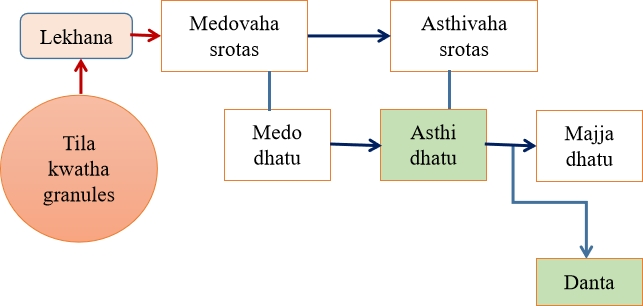‘On Time On Date....’
Tila kwatha granules is the user friendly modification of Tila kwatha mentioned in Ashtanga hridaya Gulma prakarana. The additives like Vyoshabharngi choornam and Guda are incorporated proportionately to design granule form. Thus by providing palatability and fast absorption.The medicine is given in menstrual abnormalities like oligomenorrhoea, secondary amenorrhoea, PCOS, dysmenorrhoea etc. The medicine can be used in different age group for different purposes.
Classical indication: Rakta gulma, Nashta pushpa in stree
Ashtavaidya Practices: Nashtarthava, Arthava kshaya.
Regulates irregular menstruation in PCOS.
Improves menstrual flow in scanty menstruation.
Improves uterine and general health in normal adolescent girls following menarche.
Experiences reported: Management of Oligomenorrhoea, Secondary Amenorrhoea, PCOS, Osteoarthritis, Osteoporosis, Adolescent health care.
Dosage: 15 g granules twice daily before food or as directed by the physician.
Additive- Ghee is preferred for regulation of periods
Cumulative Pharmacological properties of the formulation
Madhura- Thiktha - Kashaya - Guru- Snigdha- Ushna - Vata kaphaharam- Anulomana- Rasayana - Deepana - Gulmaghna.
Pharmacodynamics
Ayurvedic point of view:
Tila kwatha granules is having madhura katu kashaya rasa, guru snigdha guna, ushna veerya and madhura vipaka. It is vata kaphaharam, lekhana, anulomana,deepana as well as balya. The medicine is useful in regulating irregular menstruation especially those associated with pain. Tila kwatha is mentioned in rakta gulma chikitsa in Ashtanga hridaya. It is modified into granule form. Both tila and guda are balya and has specific action- garbhasaya visodhana. Tila is alpamootrakrit and grahi while guda is mootrala and sara and balances each other. Guda is vrishya. The medicines works efficiently in multiple levels in the samprapthi vighatana of PCOS. Madhura rasa and vipaka along with guru snigdha guna helps in vata anulomana .The katu kashaya rasas with ushna veerya help in kapha haratwa. The lekhana karma brings medoharatwa and kapha haratwa in artavavaha srotas. Vata anulomana is important in yoni roga chikitsa. It is achieved through this medicine very efficiently. The agneya amsa of tila and specific action in artavavaha srotas focuses the medicine to the target and improves quality of artava. Vyosha improves the bioavailability of tila in the srotas. The yoga is deepana and corrects dhatwagni mandya. Conversion of rasa to rakta when corrected improves artava formation, medoharatwa and correction of medodhatwagni helps conversion of medas to asthi and thus improving asthi dhatu. Asthi kshaya is corrected. Conversion of asthi into majja when corrected reduces atilomata and adequately nourishes danta . The medicine is taken along with ghrita. Ghrita is vatapitta hara and deepana. It is sukravardhaka and vayasthapana.
Mode of action:
Mode of action of Tila kwatha granules in correcting artava and pandu samprapthi:

Mode of action of Tila kwatha granules in bone and teeth health

RESEARCH FUTURE SCOPE:
Parmacological:
To evaluate the possible in-vitro biological activities of Tila kwatha granules.
To study the physicochemical properties - In-silico toxicity and molecular docking studies of active constituents in Tila kwatha granules.
Clinical:
Efficacy of Tila kwatha granules insulin dependent PCOD - Hormonal assay.
Infertility management.
Sports medicine - Bone health.
BIBLIOGRAPHY:
Pianjing P, Thiantanawat A, Rangkadilok N, Watcharasit P, Mahidol C, Satayavivad J. Estrogenic activities of sesame lignans and their metabolites on human breast cancer cells. Journal of agricultural and food chemistry. 2011;59(1):212-21.
Mukesh KR, Gaurav K, Shiv KI, Gotmi S, Tripathi DK. Clerodendrum serratum: A clinical approach. Journal of Applied Pharmaceutical Science. 2012;2(2):11-5.
Zaveri M, Khandhar A, Patel S, Patel A. Chemistry and pharmacology of Piper longum L. International journal of pharmaceutical sciences review and research. 2010 ;5(1):67-76.
Ahmad N, Fazal H, Abbasi BH, Farooq S, Ali M, Khan MA. Biological role of Piper nigrum L.(Black pepper): A review. Asian Pacific Journal of Tropical Biomedicine. 2012 ;2(3):S1945-53.
Mao QQ, Xu XY, Cao SY, Gan RY, Corke H, Li HB. Bioactive compounds and bioactivities of ginger (Zingiber officinale Roscoe). Foods. 2019 ;8(6):185.